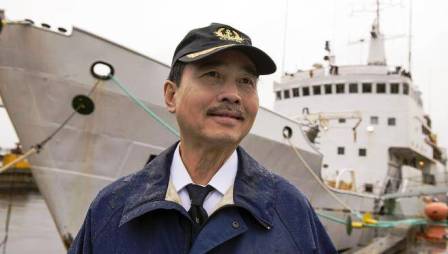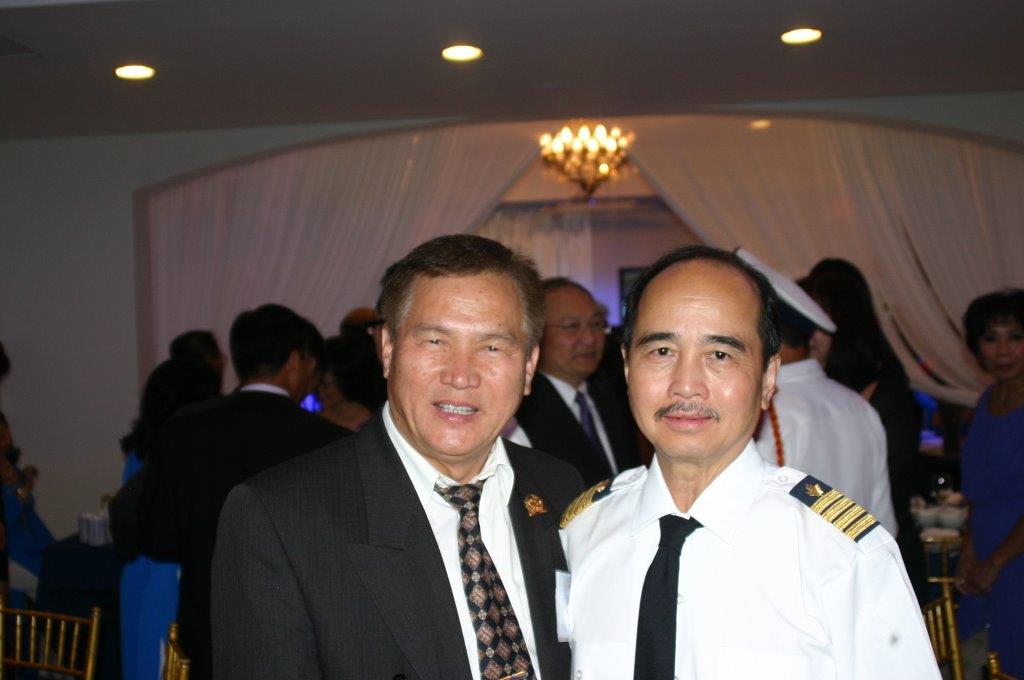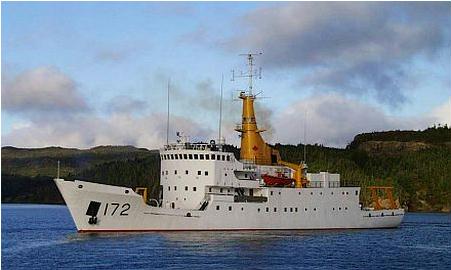Một hạm trưởng người Canada gốc Việt về hưu
Lời
tâm sự: Gặp bạn Nguyễn Ngọc Cảnh ở Đại Hội SQHQVNCH của
khoá Đệ Nhị Song Ngư, cũng như có những lần đi thăm viếng
HKMH Midway và hải đăng ở San Diego và nhiều lần nói chuyện
ở nhà bạn bè cùng khoá, tôi có dịp t́m hiểu về nghề
nghiệp của một Sĩ Quan Hải Quân thuộc Lực Lượng HQ
Canada. Theo như bạn Cảnh cho biết th́ bạn Nguyễn Ngọc Cảnh
phải trải qua nhiều khoá đào tạo nghiệp vụ từng thời điểm
khác nhau để được bổ nhiệm làm hạm trưởng từ cận duyên,
viễn duyên rồi tới viễn dương đi đến các quốc gia khác
trên thế giới. Lẽ tất nhiên những khoá học cũng khá khó
khăn và phải có nhiều cố gắng để thi đậu mới được cấp
chỉ huy bổ nhiệm tiếp.

Hạm Trưởng Nguyễn Ngọc Cảnh

Hạm
Trưởng Nguyễn Ngọc Cảnh (phải) và bạn cùng khoá SQHQVNCH,
KS N.V.Phảy (trái)
nhân dịp ĐH 40 năm Ra Khơi vào 01.09.2013 tại miền Nam
California, USA
Halifax
(Theo báo the Chronicle Herald):
Vào cuối tháng 11 năm nay, ông Cảnh Nguyễn,
một hạm trưởng của lực lượng
cận duyên của hải quân Canada, đă về hưu
sau hơn 30 năm phục vụ trong ngành hải quân.
Ông Cảnh Nguyễn, nguyên là một sĩ quan của
hải quân Việt Nam Cộng Ḥa, đă tỵ
nạn đến Halifax vào năm 1975.
Trong một cuộc phỏng vấn mới đây
của báo Chronicle Herald, ông Cảnh Nguyễn năm nay
65 tuổi, đă kể cho phóng viên báo này, về
cuộc sống gian truân của ông từ năm 1954,
khi gia đ́nh ông phải di cư từ miến
Bắc vào miền Nam.
Năm 1968 khi đang học đại học, th́ có
lệnh đôn quân, sau trận tấn công của
việt cộng vào dịp Tết Mậu Thân. Ông gia
nhập hải quân, và được gửi qua
huấn luyện ở Hoa Kỳ một thời gian.
Năm 1975, ông di tản theo đoàn người tỵ
nạn và ở tại trại tỵ nạn Indidan Town
Gap, thành phố Harisburgh, tiểu bang Pensylvania một
thời gian, trước khi được chính
quyền Canada bảo trợ qua Canada. Ông làm việc
cho công ty chuyên chở dầu Irving Oil ba năm rưỡi,
trước khi được nhận vào làm cho
lực lượng hải quân cận duyên (coast guard),
và đă đi chu du qua nhiều nước như
Mễ Tây Cơ, vùng đảo Caribean, Âu Châu và đă
từng thấy gấu trắng khi tàu lên miến
Bắc cực.
Sau hơn 30 năm làm việc cho coast guard, ông Cảnh
Nguyễn về hưu với chức hạm trưởng
( the commanding officer) của lực lượng hải
quân The Canadian Forces Auxiliary Vessel (CFAV) Quest.
November 30, 2013

Canh Nguyen is commanding officer of
the Canadian Forces Auxiliary Vessel Quest. After more than 30 years with the
Defence Department, Canh plans to retire in coming months. Nguyen came to
North America in 1975 and moved to Halifax to join a friend. CHristian
Laforce
Facilities
Specialized
Facilities
Research and
Development at Sea
DRDC Atlantic
Fact Sheet
Canadian
Forces Auxiliary Vessel “QUEST”

“CFAV Quest” in Newfoundland.
The research, development, and testing
of the systems needed by the Canadian Navy to maintain a state of
readiness for maritime warfare often requires that the laboratory be
transported to the field, so that the work can be performed under
"real world" conditions.
To this end, the Defence R&D Canada
– Atlantic employs the Canadian Forces Auxiliary Vessel QUEST.
Maintained by the Navy and manned by Maritime Forces Atlantic Auxiliary
seamen, QUEST conducts 7 to 10 trials per year, spending up to 160 days at
sea. These trials encompass a wide range of R&D activity, from
research on the acoustic properties of the ocean to experiments on ship
signatures and safety. As well, the evaluation of prototype acoustic
detection systems is often the first step in the process leading to
procurement of new systems for the Navy.
This broad range of R&D activities
requires a capable and versatile vessel, thus QUEST was designed with
spacious laboratories, large working deck areas, and very capable marine
cranes and specialized equipment handling systems. The vessel was designed
with a large margin of stability and this, combined with its
roll-stabilization system and constant displacement systems, makes QUEST a
safe and stable platform from which to carry out experiments, even in
heavy seas.
Of particular note are the acoustic
quieting features of the vessel, which reduce the ship’s radiated noise
to virtually undetectable levels when the vessel is configured in its
"quiet state". QUEST has conducted research in support of other
Government Departments, Universities, and Canadian Industry, where joint
research is mutually beneficial. QUEST has participated in Canadian and
NATO naval exercises requiring the operational evaluation of prototype
equipment.
General
Designer: • Canadian Department of National
DefenceBuilder: • Burrard Shipbuilding & Drydock Ltd.,
Vancouver, Canada (1969)Construction: • General Purpose Research
Vessel (Steel), Lloyd’s Class 100A1 Ice Class1Mid Life Refit: •
Friede Goldman Newfoundland (FGN), Newfoundland, Canada (1997/99)
Ship
Characteristics
Dimensions: • 76m x 12.6m x 4.8m (length x beam
x draft) Displacement: • 2130 tonnes standard; 2200 tonnes full
loadMain Propulsion: • Diesel electric, twin shaft, twin rudder,
2 – 10 cyl. Fairbanks-Morse 38D8 diesels driving 2 – GE electric
motors Auxiliary Propulsion and Electrical: • 1 – 750kw gas
turbine driving 2 – 500kw generators in tandem Propulsion providing AC
for ship service and/or DC for propulsion and a 150kw and Electrical:
emergency diesel generator Steering: • Integrated Steering &
Autopilot RC MarineOther: • Retractable bow thruster, ship roll
stabilization system and water displacement fuel tanksMax Speed:
• 15 knotsEndurance: • 10, 000 nm @ 12 knots, 35 days
Complement
• 10 officers, 14 crew, up to 21
scientific and trials personnel
Electronics
Radar: • Racal-Decca Bridgemaster 2,
"X" band and "S" band Communication and Navigation:
• Full suite of modern navigation and communication and Navigation
equipmentSpecial: • Echo sounders • Sub-bottom profile •
Current profiler • Directional wave measurement system • Wave height
meter • Environmental sensor • Bathymetry • Expendable
bathythermograph launcher • Radio direction finder • Underwater
telephone
Unique
Features
Stabilized Electrical Power:
• In combination with fitted heavy batteries, the 125 kva uninterrupted
power supply (UPS) provides power to scientific instrumentation in the
event of shipboard power interruption, and for quiet state operations.Acoustic:
• Main propulsion diesels raft mounted and acoustically hooded with raft
de-coupled from the hull. The 750kw gas turbine, for quiet state
operations, is located in superstructure (02deck) and is also acoustically
isolated. The hull and sea-bays are coated internally with thick
visco-elastic acoustic and de-coupler tiles. Internal divisions consist of
special transmission loss bulkheads and acoustic ceilings, ventilation and
piping systems, designed to minimize noise, and the steering hydraulics
noise is suppressed. Unique, 5-bladed propellers provide low noise
performance.Laboratories and Workshops: • Spacious
"wet" and "dry" laboratory spaces capable of holding
and Workshops: up to 53 "racks" of scientific instrumentation,
plus well equipped electronics and mechanical workshops. All scientific
areas and workshops are linked to a local area computer network.